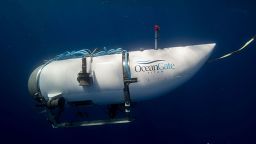Editor’s Note: Mike Reiss is an Emmy award-winning writer for “The Simpsons.” He hosts the travel podcast “What Am I Doing Here?” The views expressed here are his own. Read more opinion at CNN.
I rode in the Titan submersible less than a year ago, in July 2022. I’m familiar with the sub’s cramped confines and understand the vastness of the ocean. Finding a sub once it’s lost is like dropping a quarter into Lake Erie and hoping to get it back.
Diving to the Titanic was a thrilling, awe-inspiring, once-in-a lifetime experience, but catastrophe was never far from mind.
Before I boarded the sub, I signed a lengthy waiver detailing all the ways this trip could kill me: asphyxiation, electrocution, drowning, crushing — death was mentioned three times on the first page. I kissed my wife goodbye before I left, thinking I might never see her again.

In short, disaster was part of the package. This wasn’t a rollercoaster ride that merely seemed scary but was actually pretty safe. The danger involved was real. And the passengers on the Titan weren’t thrill-seekers — they weren’t skydivers or rich tourists who climbed Mount Everest so they could brag about it. They were explorers and scientists — people endlessly curious about the world, who had to see it with their own eyes.
I put myself in that group. I’ve visited 134 countries, some of them quite dangerous — Iran, Iraq, North Korea. During my last briefing before getting on the Titan — and there were many briefings — I was told, “There’s food on the sub, but you won’t get hungry. There’s water, but you won’t need it. There’s a toilet onboard, and it’s never been used.” And that turned out to be the case.
The trip was meant as a birthday gift to my wife: She is an intrepid traveler, and while I love a good adventure, I am much less so. I like to sit home watching action movies; she likes to live them. As for the price of the excursion, I was afraid to ask. She assured me she “got a deal.”
The great irony of our trip is that before we boarded the sub, we had to take Covid-19 tests. I passed; she failed. It was her idea and her adventure, and yet I wound up going without her.
This sub is now the subject of an intense search after going missing on Sunday during an expedition to view the wreckage of the Titanic on the ocean floor. The company that organized the venture, Oceangate, said in a statement Thursday that it appears that the passengers of the sub have “sadly been lost.” They included British businessman Hamish Harding, French diver Paul-Henri Nargeolet, Pakistani billionaire Shahzada Dawood and his son Suleman Dawood. The fifth person is OceanGate CEO and founder Stockton Rush.
Throughout my entire 10-hour journey on the Titan, I was in a state of focus and calm like nothing I’d ever felt. In fact, despite my excitement and trepidation, I fell asleep on the way down. It takes two and a half hours to descend the two and a half miles to the ocean floor, and the sub is quiet, dark and surprisingly comfortable. I woke from my nap thinking I was home in bed, and then realized I was in a steel tube 13,000 feet beneath the sea.
I quickly became aware that we were in the middle of a crisis: We were lost on the ocean floor. Our compass was spinning erratically. Directions we were getting from the surface crew monitoring the movement of the vessel didn’t correspond to what we were seeing. The Titanic, the biggest ship of its time, was just 500 meters away, but we couldn’t find it in the inky darkness.
Instantly, the five of us onboard — a pilot, three scientists and me, a man with no particular skills or training — became a team. We studied maps, plugged data into the laptop, stared out the porthole for clues to our location. It was calm, it was focused and it worked — it took us three hours, but we found the Titanic.
I’m certain that that was the mood of the five people onboard the Titan’s last journey. There would have been no panic onboard, no tears or recrimination — just pure focus on the crisis at hand. And if all that failed, I believe there was peace. The sub is a womb-like environment; the dive is a zen experience.
Get Our Free Weekly Newsletter
- Sign up for CNN Opinion’s newsletter.
- Join us on Twitter and Facebook
One thing that has given me comfort this past week is knowing that Rush was onboard the sub. He built the Titan from the ground up. I’m certain he explored every possibility for rescue, never losing his cool, creating a sense of calm among the crew. Despite the way he’s been painted in some news reports, he was methodical and obsessed with safety. His favorite book was “The Checklist Manifesto,” and, yes, it’s all about the art and science of writing checklists. He kept insisting I read it, and I knew I never would in 1,000 lifetimes.
But with this comforting thought, of course, comes sadness — for the passengers, for their families, for the dreams of the Oceangate sub company. If we’ve lost Rush, I’ve lost a friend. I spent two weeks with the guy on different expeditions. And between briefings, training sessions and those endless checklists, we had fun. I got to enjoy his endless supply of great anecdotes, bad jokes and fine Cuban cigars. He was handsome, charming, brilliant, and he lived the life every 8-year-old boy could want: He was a rocket scientist, airline pilot, inventor and submarine captain.
Rush was a great American dreamer, and his dreams were infectious. I was glad to be caught up in them. He had an impossible vision, but he made it happen a dozen times. Finally, his luck ran out, as luck will always do.
I’ve watched the narrative in the media shift from shock, to hope, and when hope fades, to blame. But when someone dies climbing Mount Everest, it’s not always the fault of the ropes or the tools or even the Sherpa who brought them there. Sometimes you just have to blame the mountain.
This article has been updated with a statement from Oceangate.

